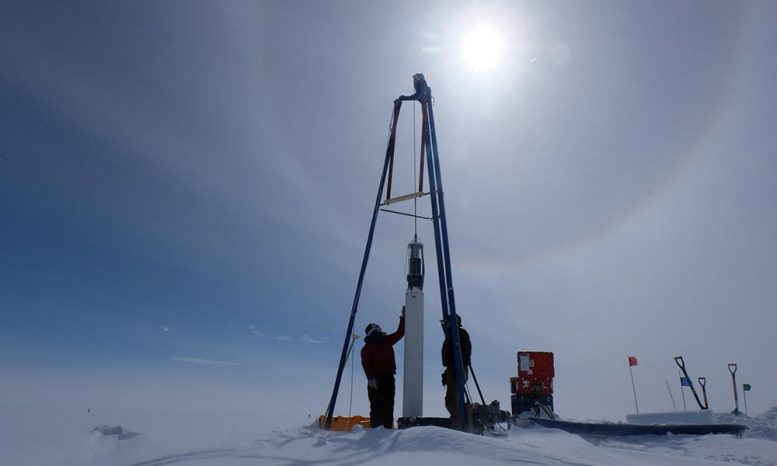
Rochester researchers in Greenland drill for ice cores, which contain air bubbles with small quantities of ancient air trapped inside. By measuring the carbon-14 isotope in air from more than 200 years ago, the researchers found that scientists have been vastly overestimating the amount of fossil methane emitted by natural sources, and have therefore been underestimating the amount of methane humans are emitting into the atmosphere via fossil fuels. Credit: Xavier Faïn / University of Grenoble Alpes
Methane is a powerful greenhouse gas and a large contributor to global warming. Methane emissions to the atmosphere have increased by approximately 150 percent over the past three centuries, but it has been difficult for researchers to determine exactly where these emissions originate; heat-trapping gases like methane can be emitted naturally, as well as from human activity.
“Methane is important to study because if we make changes to our current methane emissions, it’s going to reflect more quickly.” — Benjamin Hmiel
University of Rochester researchers Benjamin Hmiel, a postdoctoral associate in the lab of Vasilii Petrenko, a professor of earth and environmental sciences, and their collaborators, measured methane levels in ancient air samples and found that scientists have been vastly underestimating the amount of methane humans are emitting into the atmosphere via fossil fuels. In a paper published in Nature, the researchers indicate that reducing fossil fuel use is a key target in curbing climate change.
“Placing stricter methane emission regulations on the fossil fuel industry will have the potential to reduce future global warming to a larger extent than previously thought,” Hmiel says.
Two types of methane
Methane is the second largest anthropogenic—originating from human activity—contributor to global warming, after carbon dioxide. But, compared to carbon dioxide, as well as other heat-trapping gases, methane has a relatively short shelf-life; it lasts an average of only nine years in the atmosphere, while carbon dioxide, for instance, can persist in the atmosphere for about a century. That makes methane an especially suitable target for curbing emission levels in a short time frame.
“If we stopped emitting all carbon dioxide today, high carbon dioxide levels in the atmosphere would still persist for a long time,” Hmiel says. “Methane is important to study because if we make changes to our current methane emissions, it’s going to reflect more quickly.”
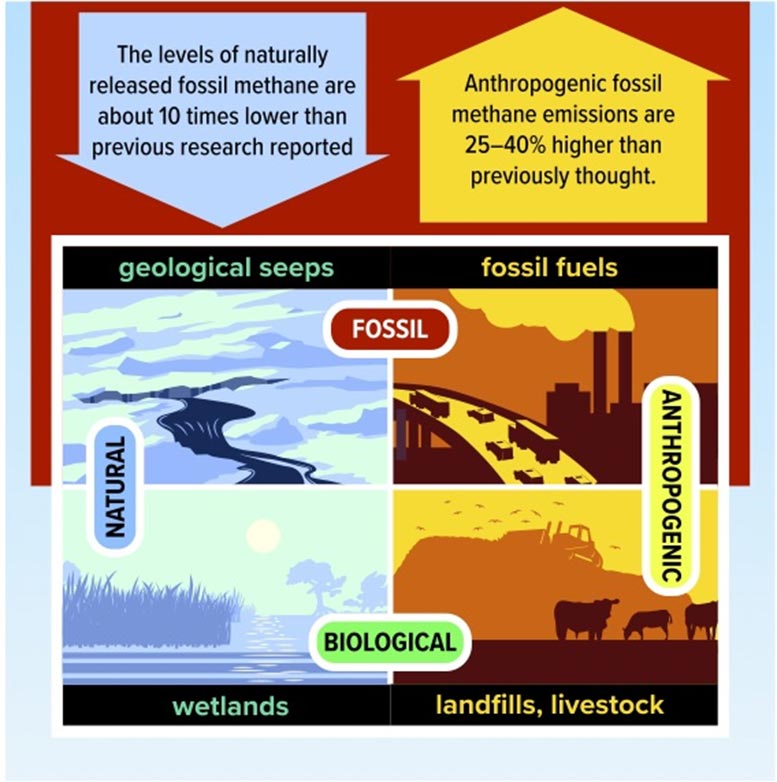
Methane emitted into the atmosphere can be sorted into two categories, based on its signature of carbon-14, a rare radioactive isotope. Fossil methane has been sequestered for millions of years in ancient hydrocarbon deposits and no longer contains carbon-14; biological methane is in contact with plants and wildlife on the planet’s surface and does contain carbon-14. Biological methane can be released naturally from sources such as wetlands or via anthropogenic sources such as landfills, rice fields, and livestock. Fossil methane can be emitted via natural geologic seeps or as a result of humans extracting and using fossil fuels. Credit: University of Rochester illustration / Michael Osadciw
Methane emitted into the atmosphere can be sorted into two categories, based on its signature of carbon-14, a rare radioactive isotope. There is fossil methane, which has been sequestered for millions of years in ancient hydrocarbon deposits and no longer contains carbon-14 because the isotope has decayed; and there is biological methane, which is in contact with plants and wildlife on the planet’s surface and does contain carbon-14. Biological methane can be released naturally from sources such as wetlands or via anthropogenic sources such as landfills, rice fields, and livestock. Fossil methane, which is the focus of Hmiel’s study, can be emitted via natural geologic seeps or as a result of humans extracting and using fossil fuels including oil, gas, and coal.
Scientists are able to accurately quantify the total amount of methane emitted to the atmosphere each year, but it is difficult to break down this total into its individual components: Which portions originate from fossil sources and which are biological? How much methane is released naturally and how much is released by human activity?
“As a scientific community we’ve been struggling to understand exactly how much methane we as humans are emitting into the atmosphere,” says Petrenko, a coauthor of the study. “We know that the fossil fuel component is one of our biggest component emissions, but it has been challenging to pin that down because in today’s atmosphere, the natural and anthropogenic components of the fossil emissions look the same, isotopically.”
Turning to the past
In order to more accurately separate the natural and anthropogenic components, Hmiel and his colleagues turned to the past, by drilling and collecting ice cores from Greenland. The ice core samples act like time capsules: they contain air bubbles with small quantities of ancient air trapped inside. The researchers use a melting chamber to extract the ancient air from the bubbles and then study its chemical composition.
Hmiel’s research expands on previous research conducted by Petrenko, but is focused on measuring the composition of air from the early 18th century—before the start of the Industrial Revolution—to the present day. Humans did not begin using fossil fuels in significant amounts until the mid-19th century. Measuring emission levels before this time period allows researchers to identify the natural emissions absent the emissions from fossil fuels that are present in today’s atmosphere. There is no evidence to suggest natural fossil methane emissions can vary over the course of a few centuries.
By measuring the carbon-14 isotopes in air from more than 200 years ago, the researchers found that almost all of the methane emitted to the atmosphere was biological in nature until about 1870. That’s when the fossil component began to rise rapidly. The timing coincides with a sharp increase in the use of fossil fuels.
The levels of naturally released fossil methane are about 10 times lower than previous research reported. Given the total fossil emissions measured in the atmosphere today, Hmiel and his colleagues deduce that the manmade fossil component is higher than expected—25-40 percent higher, they found.
Climate change implications
The data has important implications for climate research: if anthropogenic methane emissions make up a larger part of the total, reducing emissions from human activities like fossil fuel extraction and use will have a greater impact on curbing future global warming than scientists previously thought.
To Hmiel, that’s actually good news. “I don’t want to get too hopeless on this because my data does have a positive implication: most of the methane emissions are anthropogenic, so we have more control. If we can reduce our emissions, it’s going to have more of an impact.”
Reference: “Preindustrial 14CH4 indicates greater anthropogenic fossil CH4 emissions” by Benjamin Hmiel, V. V. Petrenko, M. N. Dyonisius, C. Buizert, A. M. Smith, P. F. Place, C. Harth, R. Beaudette, Q. Hua, B. Yang, I. Vimont, S. E. Michel, J. P. Severinghaus, D. Etheridge, T. Bromley, J. Schmitt, X. Faïn, R. F. Weiss and E. Dlugokencky, 19 February 2020, Nature.
DOI: 10.1038/s41586-020-1991-8
This study was supported by the US National Science Foundation and the David and Lucille Packard Foundation and is a recent example of Rochester’s initiatives to better understand the global methane budget. Scientists from Rochester’s Department of Earth and Environmental Sciences have conducted field research in Antarctica, Greenland, the Great Lakes, and Earth’s oceans, and have used machine learning and climate models to advance an understanding of the potent greenhouse gas methane and the ways it affects global warming and climate change.


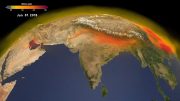




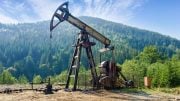
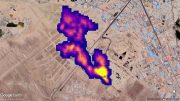
I admit it. When I try to eat a balanced diet and consume broccoli, cabbage, or brussels sprouts, I end up emitting large (very large according to my wife) amounts of methane gas. I’m in a quandary. Should I eat a balanced diet to keep me healthy and lengthen my life, or should I shun all things green in my diet to save the planet?
What about fish?? Has anyone studied how much methane fish emit?? My gosh this stuff is such utter nonsense. All the models are so skewed and just like statistics can make them say whatever the person entering the data wants them to say. Only way to fix this is tax everyone, the rich especially and rich countries, then close down all power plants and only use windmills. Put us back into the good ol days before the industrial revolution and people. Hell bring back the dinosaurs! They can cause climate change……or can they?
Some fish swallow air and use it for communication. But it’s just air, not methane.
So, no; Fish don’t fart.
https://www.leisurepro.com/blog/ocean-news/science-corner-do-fish-fart/
So it’s not the cows then!!
Back in 2009, I sat through a fascinating presentation by Dr. Stuart Strand at a Defense Science Board meeting. It turns out that the US corn crop filters the entire atmosphere about once a year. His proposal was to put 5 genes from methane eating bacteria into corn and let the corn clean out the methane. It would cause a minute increase in the productivity of corn.
So if we want to clean the methane out of the atmosphere, there is probably a way to do it.
Look! Everybody knows man made pollution doesn’t affect the environment. Therefore, there is no man made climate change or global warming.
Is this a dermal emission, or is it from an orifice?
Thats it! Time to eradicate humans. Lets start with the doomsday scientists!
the editor needs to be ridiculed for not knowing what noun to put before the word “emitting “
@Gino
Yes, that is a quandary that environmentalists do not address. I would suggest you carry on emitting all that methane yourself. The alternative would be to eat more meat, which would lead to the source of the meat emmitting far more methane than yourself due to conversion losses in processing nutrition in your gut. What we really need is a wearable personal methane capture and recycling unit.
Humans never accept any responsibility for anything they have done to contribute to the problem. Move on. It always gets worse. Why? Because humans NEVER do anything but create problems.
So to understand this, the earth was to be in perfect balance after the “warm-up” after the last ice age? Wouldn’t the same contributors that have steadily warmed our plant after the ice age, still be in effect?
If natural methane emissions is 10 times less than previously thought, that means 1000% less natural methane. Do we known 1000% less of what quantity to compare it to the increase of 40% in human made methane?
“Methane Emitted by Humans…”
Indeed.
Are we going to sue Taco Bell?
People won’t change their habits if it affects their comfort. (Sadly).
Check out the US EIA database to see that the utility industry leaks into the atmosphere roughly 2% of the methane it uses. That’s a lot of methane and the amount is growing as the industry converts from coal to nat gas (methane).
The hilarious evolution of the man-made climate change deniers’ claims:
“1. This isn’t happening.
2. If it is happening, it isn’t our fault.
3. If it is happening, and it’s our fault, there’s nothing we can do about it.
4. If it is happening, and it’s our fault, and there’s something we can do about it, it’s too expensive.
5. If it is happening, and it’s our fault, and there’s something we can do about it, and it’s not too expensive, China won’t do it with us.
6. If it is happening, and it’s our fault, and there’s something we can do about it, and it’s not too expensive, and China will do it with us, well, it’s too late now.
7. Al Gore is fat and has a big house and also it snowed last winter somewhere. Plus hockeysticks and emails and CO2 is good for plants and what about that Newseek article about global cooling from 40 years ago?
I think that should cover everything.
There are several types of motivation for being a climate change denier:
1. Fossil fuel industry business interests – greed
Exxon scientists were among the first to discover man-made global warming, but they quickly swept their findings under the carpet after the company bigwigs realized the’re bad for business.
2. Right wing pols getting into the nether orifices of the fossil fuel industry – protecting their jobs
The industry is a huge donor to the Pubes. They have them in their deep pockets. The right wing media support unconditionally the party line and trumpet their skepticism on a daily basis, scaring their listeners into thinking that measures to reduce CO2 emissions will produce huge job losses when the opposite is true.
3. Wingnuts in the street
Their motivation is manifold. They are under the barrage of Fox and AM radio propaganda, and since they’re suspicious of those college types in general (aka American anti-intellectualism), they’re an easy prey to the opposing view. Also, quite importantly, admitting that climate change is real and man-made could produce a sense of guilt in some of them for driving huge gas-guzzlers or not caring about the environment in general. It’s much easier to deny the existence of danger and thus assuage one’s conscience.
4. There are a few crackpot scientists who are either shills for the fossil fuel industry or sincerely believe that climate change either doesn’t exist or it’s not man-made. Their credibility with mainstream climatologists is zero.
This is a bunch of hooey! There’s nothing NEW under the sun, therefore, there would be evidence of past ‘global warming’ and resulting planet damage. Show me I’m from Missouri…
When I was in Iraq back in 2006 I witnessed multiple oil facilities vent off unknown amounts of natural gas. The flares were only lite under inversion layer conditions. Oil comes out of the ground like water. The initial stage of separating oil from gas is easy. However, the reward/effort to separate natural gases is more difficult. It is easier to take the oil and flare/vent the gas.
We are told:
“Methane is a powerful greenhouse gas and large contributor to global warming.”
But we are NEVER told how much methane will actually contribute to warming, you know, like how much it will actually warm the planet in degrees by 2100 or if it doubles. Nope nada “they” don’t want you to know that it’s very likely to be only a very small fraction of a degree.
Steve Case – Milwaukee, WI
Observer is correct. The flaring-off of methane from oil and gas wells has been camouflaged, obscured, hidden, denied, legislated for and then reversed numerous time which seems to have the desired effect. A permanent muddle. May I suggest that our current circus media style of government does great harm to the image the public receives far above what the Congress imagines the harm to be. A lot less corporate graft is called for; and if possible, a revisiting of honesty often proclaimed and never seen. Maybe a THE BUCK STOPS HERE sign for Prez Trump’s desk?
The article states, “By measuring the carbon-14 isotopes in air from more than 200 years ago, the researchers found that almost all of the methane emitted to the atmosphere was biological in nature until about 1870. That’s when the fossil component began to rise rapidly. The timing coincides with a sharp increase in the use of fossil fuels.
The levels of naturally released fossil methane are about 10 times lower than previous research reported. Given the total fossil emissions measured in the atmosphere today, Hmiel and his colleagues deduce that the manmade fossil component is higher than expected—25-40 percent higher, they found.”
I would think you should also look at these two items:
1. The rise in world population between 1850 about 1,238,500,000 and 1950 about 2,498,200,000 and 2000 about 6,042,166,670, and 2016 about 7,371,500,000.
2. The rise in production and consumption of cows, goats, sheep, and pigs during the same time period.
Both of these, plus the effect of global warming and proliferation of infectious diseases must also be factored in before we can find a viable solution (see: https://scitechdaily.com/vicious-cycle-climate-change-spreading-infectious-diseases-which-contribute-to-climate-change/)
I can’t do much to stop global warming, but at least I can call out destructively ignorant opinions when I see them. Climate change IS real, is caused by humans, and needs to be stopped immediately so that fewer people die needlessly. People who say otherwise are actively contributing to the deaths of future humans and also to short-term economic instability.
Here’s NASA saying that it’s real and is caused by humans:
https://climate.nasa.gov/
You can easily tell it’s a real government website because it has “.gov” in the web address.